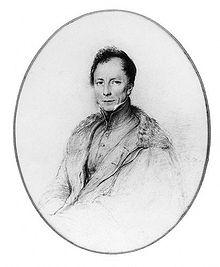Henry Kater
Appearance
Henry Kater | |
|---|---|
 | |
| Born | 16 April 1777 Bristol, Great Britain |
| Died | 26 April 1835 (aged 58) |
| Nationality | English |
| Awards | Copley Medal (1817) Gold Medal of the Royal Astronomical Society (1831) |
| Scientific career | |
| Fields | Physics |
Henry Kater FRS, FRAS (16 April 1777 – 26 April 1835) was a British physicist of German descent.
Early life
He was born at
Great Trigonometric Survey. Failing health obliged him to return to England; and in 1808, then a lieutenant, he entered on a student career at the Senior Division of the new Royal Military College at High Wycombe. Shortly afterwards he was promoted to the rank of captain. In 1814 he retired on half-pay, and devoted the remainder of his life to scientific research.[1]
Scientist
His first major contribution to science was the comparison of the merits of the
Cassegrainian and Gregorian telescopes; Kater determined the latter to be an inferior design.[1]
His most substantial work was the invention of
order of St. Anne; and the same year he was elected a Fellow of the Royal Society. In 1826, he was elected a foreign member of the Royal Swedish Academy of Sciences. Kater was elected a Foreign Honorary Member of the American Academy of Arts and Sciences in 1832.[5] In 1833 he was elected a fellow of the Royal Astronomical Society.[1]
He won the Copley Medal in 1817 and the Gold Medal of the Royal Astronomical Society in 1831.
He is considered as the inventor of the prismatic compass, patented a year later by Charles Schmalcalder. He also studied
Memoirs of the Royal Astronomical Society for 1831–1833 — one on an observation of Saturn's outer ring, the other on a method of determining longitude by means of lunar eclipses.[1]
Works
- Description of a floating collimator. London: William Nicol. 1825.
References
- This article incorporates text from a publication now in the public domain: Chisholm, Hugh, ed. (1911). "Kater, Henry". Encyclopædia Britannica. Vol. 15 (11th ed.). Cambridge University Press. p. 695.
Notes
- ^ a b c d Chisholm 1911.
- ^ Playfair, John (1818). "Review: An Account of Experiments for Determining the Length of the Pendulum Vibrating Seconds in the Latitude of London by Captain Henry Kater, F.R.S." Edinburgh Review. 30: 407–426.
- ^ Philosophical Transactions of the Royal Society, 1825, 1828.
- ^ Phil. Trans., 1821, 1831.
- ^ "Book of Members, 1780–2010: Chapter K" (PDF). American Academy of Arts and Sciences. Retrieved 8 September 2016.
- ^ On the Best Kind of Steel and Form for a Compass Needle; Phil. Trans., 1821.
External links
Wikisource has the text of the 1885–1900 Dictionary of National Biography's article about Kater, Henry.
